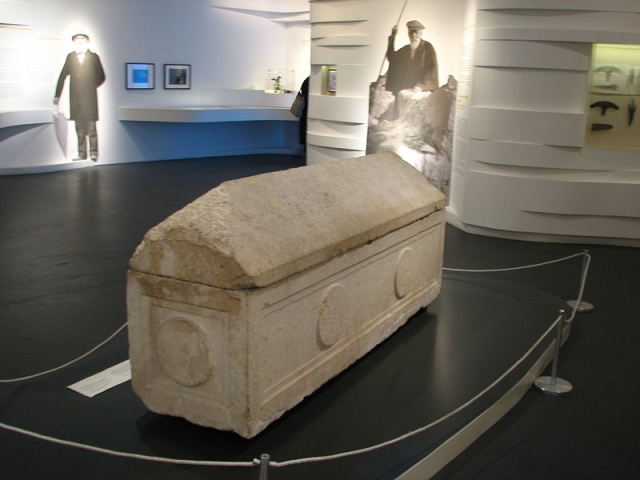On December 6th, 2007, an Israeli-led archaeological dig discovered the remains of a 2,000-year-old palace in the Old City of Jerusalem, most likely a palace belonging to Queen Helena of Adiabene. Queen Helena was a prominent Jewish convert figure of the late Second Temple era, converting in 30 AD and likely died sometime in the 50s of that same century.
Archaeologists who examined the massive house concluded the building was two stories tall and was demolished by the Romans during the Great Jewish Revolt in 70 AD. The structure was found after a six-month dig in a parking lot outside the walls of Jerusalem near the Dung Gate. The Israel Antiquities Authority archaeological team, led by Doron Ben-Ami, identified a 16-foot wall and living quarters along with valuable coins, ritual baths (Mikvahs), and many more stunning artifacts.
The sarcophagus of Queen Ṣadan, discovered among the Tomb of the Kings in the Kidron Valley, typically dated to the 1st CE.
— Simcha Gross (@Simcha_Gross) January 16, 2022
Her identity is unknown. Some argue she is Helena of Adiabene.
It has 2 Aramaic inscriptions:
צדן מלכתא
צדה מלכתה
ṣdn mlktʾ
ṣdh mlkth
In @MuseeLouvre pic.twitter.com/9S4hRfxY8i
Helena or “Heleni” in Hebrew, was described by the notable Jewish historian of the time, Josephus Flavius, as kind and heavily involved in philanthropy within the Jewish community of Israel. She was the sister and wife of King Monabazus Bazaeus. Along with other members of her family, Helena converted to Judaism.
According to Josephus who wrote about her from first-hand experience, on a pilgrimage to Jerusalem, Helena was saddened by the poverty within Jerusalem’s walls. With some wealth and nobility, she was able to gather grain from Egypt and dried figs from Cyprus to distribute to the people of Jerusalem. Helena spent her remaining years traveling between Adiabene, a former Persian province of northern Iraq, and her Jerusalem palace.
Queen Helena of Adiabene and Her Sons in Midrash and History - https://t.co/JBDkoZ8dqg
— Please Join #Mastodon! Mstdn.Social/@JClickbaited (@JClickbaited) June 9, 2022
The Talmud mentions Helena and actually claims that she went through a 21-year period of being a Nazirite. when her son went to war, said, ‘If my son returns in peace from the war, I shall be a Nazirite for seven years.’ Her son returned from the war, and she observed a Naziriteship for seven years. At the end of the seven years, she went up to the land [of Israel] and Beth Hillel ruled that she must be a Nazirite for a further seven years. Towards the end of these seven years, she contracted ritual defilement, and so altogether she was a Nazirite for twenty-one years.”
Helena Hazabani or Helena of Adiabene was Queen in Hewlêr (Erbil) and Riha (Urfa/Edessa) in the first century. She was probably born into a Zoroastrian family but later converted to Judaism. Helena was noted for her generosity and helped Jerusalem during a famine in 45-46 CE. pic.twitter.com/c8VD6fXqMk
— Polla Garmiany ☀️ (@PollaGarmiany) September 23, 2019
Helena was buried in a grave constructed with her funding during her lifetime. Some claim a French archaeologist, Louis Felicien Caignart de Saulcy, discovered her tomb in the middle of the 19th century during excavations of the “Tombs Of The Kings” complex. “tsada malkata”, which roughly translates into “Our servant, the queen”, was visibility engraved on her Sarcophagus.


